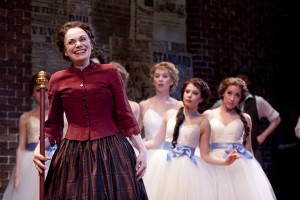
Alma Cuervo as Mme. Gimaud speaks on behalf of her French ballet troupe in 'And the Curtain Rises,' the current production at Signature Theatre in Arlington. It runs through April 10. (Photo by Scott Suchman; courtesy of Signature)
Signature Theatre’s “And the Curtain Rises” is definitely a backstage story — and nothing reinforces this more than set designer Beowulf Boritt’s clever rendition of a 19th century Manhattan theater.
For much of the new musical comedy, we observe the action from a traditional perspective; but at other times, when the set’s back wall opens to reveal a sea of red plush seating and the actors look upstage toward an imagined audience, suddenly we’re sharing their point of view. It’s a marvelous bit of stage magic that ups the immediacy of the experience.
A tribute to the American musical, “Curtain” revisits one of the first times music, words and dance came together on a New York City stage — the making of “The Black Crook,” an actual 1866 extravaganza that enjoyed a long run at Niblo’s Garden Theatre and toured the country for decades afterward. This groundbreaking musical prototype resulted after a French ballet troupe (stranded after the theater where they were booked burnt to the ground) joined forces with a cast of dramatic American actors and came up with something entirely new.
But as “Curtain’s” creators — composer Joseph Thalken, librettist Michael Slade and lyricist Mark Campbell (all of whom are gay, by the way) — relay in the program notes, while the trio has researched this post Civil War theater moment, they have totally re-imagined it in their own way, allowing them not only to focus on collaboration and community, but also to contrive a backstage tale riddled with duplicity, sex, love and rivalry.
Staged by New York-based director Kristen Hangii, the action kicks off auspiciously with Niblo’s cigar-chomping stage manager Timoney (William Diggle) casually lighting the stage’s gas footlights as he takes us back to a time before “wristwatches and electric lights” when today’s idea of a musical didn’t exist. Soon after however, things devolve, at least temporarily. The first act with its plodding storyline — novice director/producer William Wheatley (Nick Dalton) struggles to please both a disdainful playwright Charles Barras (Sean Thompson) and some unhappy actors while trying to turn a bad melodrama into a certain hit — is essentially a drawn-out set up for the musical innovation that takes place later in the show. It can be tiresome.
After intermission, things improve significantly: There’s a rousing can-can number (quite the scandal in the 1860s) and a budding same-sex romance between the company’s veteran actor played by the excellent Erick Devine, who is gay, and the ballet troupe’s talented Hungarian accompanist (Brian Sutherland); as well as memorable music including “Stay,” William’s balladic plea to his production’s leading lady, Millicent Cavendish (Rebecca Watson), an aging ingénue with whom he’s falling in love. Overall, the pacing quickens considerably and the jokes are less stale.
“Curtain” was especially commissioned by Signature as part of its American Musical Voices Project. As such the work benefits from the Tony Award-winning company’s full treatment: Boritt’s clever set is beautifully lit by Colin Bills. Kathleen Geldard’s post- Civil War period costumes are impeccable — from the men’s fine jackets and ladies’ hoop skirt dresses to the ballerinas’ pretty, Degas-inspired dance gear.
Mostly young but peppered with a few more seasoned performers (like the excellent Alma Cuervo as a resourceful ballet mistress), the energetic ensemble cast is terrific and in very good voice, particularly Dalton and Watson as William and Millicent. Thalken’s melodic score (superbly executed by a small orchestra conducted by Boko Suzuki) is contemporary for sure, but makes wonderful, sporadic reference to the waltz and the lively march, popular musical forms of the era.
Uneven but fun and well-produced, “Curtain” offers glimpses into the first days of American musical theater, onstage and off.